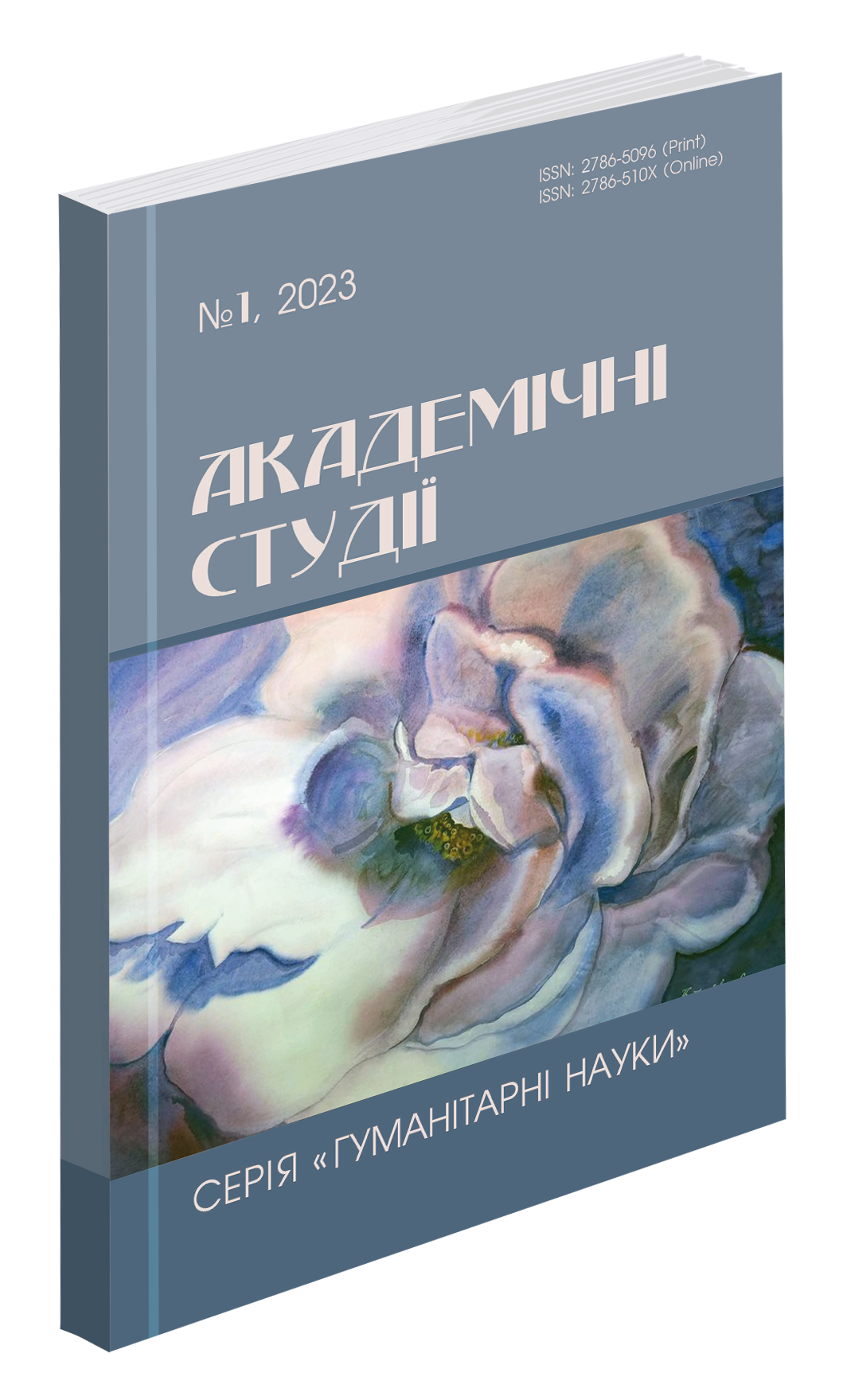Abstract
The article aims to study the theory of narrative in general and narrative as a literary text with reference to classical, Aristotelian poetics in the poststructuralism period. The presented research emphasizes the importance of addressing the concepts of narrative theory (or the science of storytelling): “history” (histoire) and “discourse” (discourse), “action” (praxis) and “plot” (mythos), their role in the reinterpretation of narrative categories. The relevance of the proposed research lies in the development of the poststructuralist direction of narratological research, arising in connection with ancient ideas about literature, aimed at involving cognitive theories, but not denying the theoretical foundations laid out by Aristotle. The research reveals the importance of categories of narrative, such as “character”, “plot”, “action”, “context” in the works of S. Chatman and P. Brooks. The mentioned categories are analyzed as a positive/negative action of the character in the dynamic unfolding of the plot, which becomes possible due to the active cooperation of the reader − his desire to understand fictional events. Thus, on the one hand, narrative categories are traditional, providing a normative, objective structure, and on the other hand, they tend towards subjectivity, individual perception and interpretation. Fictional texts of modernism and postmodernism distinguish the events and characters of the narrative in terms of categories “good ↔ bad” − a characteristic feature is the psychologization of the prose, giving ambivalent signs to the depicted events, focusing not on the dynamics of the action, but on the inner world of the characters. The poststructuralist approach emphasizes the role of the reader as an active participant in the communicative (author → text ↔ reader) and cognitive process (narrative ↔ plot ↔ interpretation of the plot). Poststructuralism does not develop as an antithesis to structuralism advanced by J. Genette, A.-J. Greimas, T. Todorov: on the contrary, the universal structure of the narrative and its categories are expanded along the lines of cognitivism, involving a number of mental processes: perception, understanding, reasoning and awareness. At the same time, the narrative is a source of embodiment of the author’s experience, an author’s fictional “model”, projected as reader knowledge.
References
Бехта І. А. Художній текст у сфері новітніх когнітивних студій. Закарпатські філологічні студії: науковий журнал / голов. ред. І. М. Зимомря. Ужгород : Видавничий дім «Гельветика», 2019. Т. 1. Вип. 9. С. 57–62.
Бехта І. А. Оповідний дискурс текстової епохи англійськомовного модернізму. Людина. Комп’ютер. Комунікація : збірник наукових праць. Львів : Львівська політехніка. 2017. C. 140–143.
Бехта І. А., Гук М. О. Поняття наративного аналізу і основні підходи. Молодий вчений. 2020. № 11(87). С. 430–435.
Alber, J. & Olson, G. (2017). How to do things with narrative: Cognitive and diachronic perspectives. Berlin : Walter de Gruyter.
Baetens, J. (2018). Stories and storytelling in the era of graphic narrative. In I. Christie & A. van den Oever (Eds.), Stories (pp. 27–44). Amsterdam: Amsterdam University Press. https://doi.org/10.2307/j.ctv5rf6vf.6
Bal, M. (1997). Narratology: Introduction to the theory of narrative (2nd ed.). Toronto : University of Toronto Press.
Bal, M. (2017). Narratology. Introduction to the theory of narrative (4th ed.). Toronto : University of Toronto Press.
Bordwell, D., Staiger J., & Thompson K. (1985). Classical Hollywood cinema. New York : Columbia University Press.
Brooks, P. (1984). Reading for the plot: Design and intention in narrative. Cambridge, MA : Harvard University Press.
Chatman, S. (1978). Story and discourse: Narrative structure in fiction and film. New York ; London : Cornell University Press.
Culler, J. (1975). Structuralist poetics: Structuralism, linguistics, and the study of literature. Ithaca : Cornell University Press.
Dawson, A. (2021). Narrative. In Studying The Lord of the Rings (pp. 19–43). Liverpool : Liverpool University Press. https://doi.org/10.2307/j.ctv1vtz8mq.6
Genette, G. (1988). Narrative discourse revisited. Ithaca: CUP.
Gerrig, R. J. (2018). Experiencing narrative worlds: On the psychological activities of reading. New York : Routledge.
Hardison, O. B., Jr., & Golden, L. (Eds.). (1968). Aristotle’s Poetics: A Translation and commentary for students of literature. Englewood : Prentice-Hall.
Herman, L. & Vervaeck, B. (2019). Handbook of narrative analysis (2nd ed). Lincoln: University of Nebraska Press.
Hingston, K.-A. (2019). Articulating bodies: The narrative form of disability and illness in Victorian fiction. Liverpool : Liverpool University Press.
Horstmann, J. (2018). Theaternarratologie: Ein erzähltheoretisches Analyse-verfahren für Theaterinszenierungen. Berlin : Walter de Gruyter.
Lanser, S. (1981). The narrative act: Point of view in prose fiction. Princeton : Princeton University Press.
Lauretis, T de. (1984). Alice doesn’t. Bloomington : Indiana Univ. Press.
Leitch, T. (1986). What stories are: Narrative theory and interpretation. University Park : Pennsylvania State University Press.
Luck, C. (2020). Linguistics and literature. Rewriting Language: How Literary Texts Can Promote Inclusive Language Use (pp. 14–52). L. : UCL Press.
Melnychuk O., Bondarchuk N., Bekhta I., Levchenko O., Yesypenko N. & Hrytsiv N. (2022). The quantitative parameters in computer-assisted approach: Author’s lexical choices in the novels by Martin Amis. Proseedings of IEEE 17th International Conference on Computer Science and Information Technologies (CSIT), Lviv, 10–12 November, 89–92.
Pier, J. (Ed.). (2020). Contemporary French and Francophone narratology. Columbus : The Ohio State University Press.
Pratt, M. L. (1977). Toward a speech act theory of literature. Bloomington : Indiana University Press.
Smith, B. H. (1981). Narrative versions, narrative theories. In W. J. T. Mitchell (Ed.), On Narrative (pp. 209–232). Chicago : University of Chicago Press.
Soberon, L. (2021). The ultimate ride: A Comparative narrative analysis of action sequences in 1980s and contemporary Hollywood action cinema. Journal of Film and Video, 73(1), 18–32. https://doi.org/10.5406/jfilmvideo.73.1.0018
Todorov, T. (1969). Structural analysis of narrative. Novel, 3, 70–6.
Warhol, R. R. & Lanser, S. (2015). Queer/feminist narrative theory. Columbus : Ohio State University Press.

